Posted on
August 21, 2017 by
Tyrion Smith
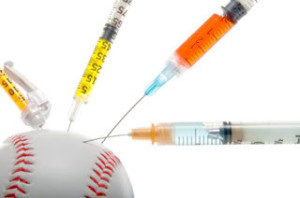 Witnessing the whole BALCO fiasco and long trials of Barry Bonds along with Mark McGwire would have made you wonder that these are the first cases of doping in sports, especially in baseball, but that’s farther from the truth. Yes, the baseball doping was highlighted way more than other incidents of steroid use by athletes in the US, partially because of congressional hearings in 2005 and critically acclaimed movie ‘Bigger, Stronger, Faster’.
Witnessing the whole BALCO fiasco and long trials of Barry Bonds along with Mark McGwire would have made you wonder that these are the first cases of doping in sports, especially in baseball, but that’s farther from the truth. Yes, the baseball doping was highlighted way more than other incidents of steroid use by athletes in the US, partially because of congressional hearings in 2005 and critically acclaimed movie ‘Bigger, Stronger, Faster’.
Initial Phase
The fact is doping history in sports goes all the way back to ancient Rome when chariot racers were used to drink an herbal pre-workout of sorts before races, heightening their focus and endurance. That’s one of the earliest forms (100 AD) of competitive sports known to mankind. Fast forward to 1889, and ironically, a baseball player openly admitted using testosterone, a rather organic form derived from pigs and dog’s testicles. Sure, there were few instances of athletes experimenting with caffeine and liquor here and there, but come on, caffeine and booze can’t be considered doping despite their proclaimed performance enhancing effects.
First Causalities
Soon after the use of testosterone in 1889, the world witnessed the horrors of steroids in 1896 when Ephedrine intake caused death of English cyclist, A.Linton. Then in 1904, Tom Hicks collapsed at St. Louis marathon, and though he won the event, doctors proved use of Strychinine and Cognac.
The Booming Period
After that we saw a boom in the use of drugs that enhance performance of humans to somewhat super human level, across sports and in wars as well. Call it leaked secretive documents or conspiracy theories, soldiers in WW II were given Amphetamines to boost their endurance and focus, both Allied and Axis.
Finally, we see the mid-1900s, when the use of anabolic steroids was rampant and we witnessed highly tuned muscular physiques. It was the era of superiorly muscular bodybuilders like Sergio Oliva, Arnold and later Dorian Yates, Ronnie Coleman and Phil Heath ushered a ground-breaking phenomenon where human limits were pushed to the max. Soon HGH joined the list of anabolic doping agents as the most potent activist. Ironically, the very sport of bodybuilding highlighted the absolute potential of HGH and doping agents, in addition to its side effects. The number of causalities and deaths directly related to abuse of HGH, insulin and anabolic steroids, in bodybuilding is among the highest and the facts are widely documented on social media. However, that happens only when you misuse them. Learn more about HGH here. Read the rest of this entry →
Tags: Barry BondsBen JohnsonDopingMark McGwire
Category
Baseball, General, Health & Fitness, Sports Fitness, Sports History
Posted on
September 01, 2013 by
Dean Hybl
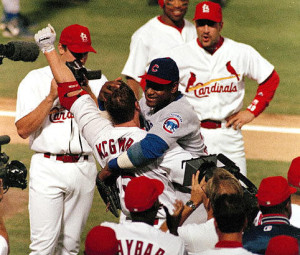
Sammy Sosa and Mark McGwire seemed larger than life when they captivated the baseball world in 1998.
When someone tells you that something seems too good to be true, all you have to think about the 1998 baseball season to know that is indeed a true statement.
It is hard to believe that it was 15 years ago when Mark McGwire and Sammy Sosa captivated the sports world with a display of home run power that helped many fans forget the loss of the World Series to a labor dispute just three years earlier.
Whether it was watching them blast bombs in the batting cages prior to the game or long home runs during the game, fans couldn’t get enough of the two home run heroes.
At the time, fans marveled that these two superstars were able to annihilate one of baseball’s most honored records after it had withstood very few challenges over 37 years since being set by Roger Maris.
However, though there were some hints about possible use of artificial means by McGwire they were quickly dismissed as neither the media nor fans clearly understood just how much of an impact pills in a bottle could have on player performance.
Sure it seemed a little odd that after having just three players hit 50 or more home runs (and none more than 52) in a season between 1962 and 1994, the 1998 campaign marked the fourth straight with at least 50 home runs and third straight with more than one.
However, “everybody loves the long ball” was the new credo of baseball and fans were streaming back to the ballparks to see balls fly over the fence. Read the rest of this entry →
Tags: Mark McGwireSammy Sosa
Category
Baseball, Sports History
Posted on
October 01, 2011 by
Dean Hybl
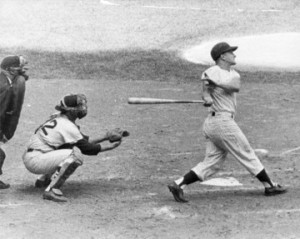
It was 50 years ago that Roger Maris blasted a record 61 home runs in a single season.
It was 50 years ago today, October 1, 1961, that New York Yankees slugger Roger Maris broke what many thought was an unbreakable record by swatting his 61st home run of the season. Though his mark has now technically been eclipsed on six occasions by three different players, the accomplishment is still considered to be something special and now that there is testing for performance enhancing drugs might never again be topped.
Though Maris had been the American League MVP in 1960, no one expected him to threaten Babe Ruth’s hallowed mark of 60 home runs in a single season.
In the 33 years since Ruth had hit 60 home runs in 1927 the 50 home run plateau had been reached only 10 times with Jimmie Foxx in 1932 and Hank Greenberg in 1938 coming the closest with 58 home runs each.
The way Maris started the 1961 season, no one could have predicted that he would finish the campaign by breaking Ruth’s record.
Maris hit only one home run in 15 games during April and through the first 28 games of the campaign had only three homers.
Then on May 17th he started a streak of four straight games with a home run and then added five more home runs the rest of the month to enter June with 12 home runs.
Maris wasn’t the only Yankee who entered June with double digits in home runs. Mickey Mantle blasted seven homers in each of the first two months to enter June with 14 home runs.
In June, Maris slugged 15 homers and Mantle 11 to give both players totals near the pace of Ruth as the season neared its mid-point.
When the Yankees played their 81st game on July 8th, Maris had 32 home runs and Mantle 29 to put both players in range of the record.
Maris blasted four home runs in a double header against the Chicago White Sox to give him 40 for the season and people started to discuss the possibility that Ruth’s record could be in jeopardy.
When Maris then went eight straight games without a home run and ended up having one homer in a 16 game stretch, the attention started to shift to Mantle, who was still blasting long balls. Read the rest of this entry →
Tags: Babe RuthMark McGwireMickey MantleNew York YankeesRoger Maris
Category
Baseball, Great Moments, Sports History
Posted on
July 16, 2011 by
Dean Hybl
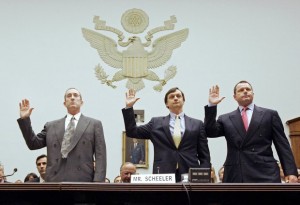
Roger Clemens was on trial for lying during a 2008 Congressional hearing.
Given that the “Steroid Era” in baseball has been built on a series of lies, accusations and uncertainties, it seems almost normal for baseball’s darkest era to come to an end with a mistrial in a federal courtroom that accomplished nothing and left as many questions as answers.
Ever since baseballs started flying out of stadiums at uncanny rates beginning in the early 1990s, the game of baseball has been in a civil war between those who believe in preserving the history and sanctity of the sport and those who saw the opportunity for greater success through artificial means.
This battle has left baseball with nearly two decades of inflated statistics and history that no one really knows what to do with.
Baseball purists have always pointed to the purity of statistics as being one of the components that make baseball special. For generations they contended that you could directly compare the statistics of players like Joe DiMaggio, Tris Speaker and Lou Gehrig with Hank Aaron, Willie Mays and Sandy Koufax to legitimately determine the greatest players of all-time.
Now in reality that argument is unsupportable as each era has its own nuances that make it difficult to compare with other generations.
Frank “Home Run” Baker earned his nickname by leading the American League in home runs four consecutive years between 1911 and 1914. During those four seasons, he blasted a combined total of 42 home runs, including 9 to lead the league in 1914. Yes, NINE! He finished his 13-year career with 96 home runs and 103 triples.
Just a few years later, a giant lefthander pitcher named George Herman “Babe” Ruth switched from being one of the American League’s most dominant pitchers to being its greatest slugger. He led the AL with 11 home runs in just 95 games in 1918 and in his first full season playing in the field in 1919 set a new single season record with 29 home runs. He hit 54 home runs in 1920 and 59 the following year and in 1921 became MLB’s career a home run leader, a distinction he would hold until 1974. Read the rest of this entry →
Tags: Jose BautistaMajor League BaseballMark McGwireRoger ClemensSammy SosaSteroids
Category
Baseball, Sports History
Posted on
January 13, 2010 by
Todd Civin
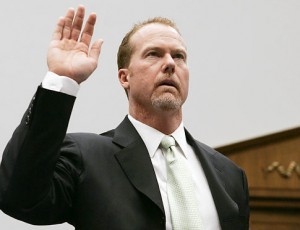 Although Jimmy Dugan told me, “There’s no crying in baseball” I didn’t listen the other day. I cried a lot. So did Mark McGwire. Only the difference between me and Mark McGwire is that we cried for two different reasons.
Although Jimmy Dugan told me, “There’s no crying in baseball” I didn’t listen the other day. I cried a lot. So did Mark McGwire. Only the difference between me and Mark McGwire is that we cried for two different reasons.
McGwire cried because he had painted himself into the proverbial corner. Caught with his hand in the cookie jar. His lie had taken on a life of it’s own and gnawed into his belly each and every day since…well, since Tony LaRussa offered him a job as hitting coach.
His tears were contrived. His tears were the creation of some Spin City PR guy who told him that in this case, you can cry in baseball.
My tears were spontaneous tears. Real tears. Tears that I have no shame in showing the baseball world. Read the rest of this entry →
Tags: Baseballjason grilliMark McGwiremlbSteroids
Category
General
Posted on
January 12, 2010 by
Richard Marsh

Mark McGwire admitted to steroid use, but believes it didn't impact his success.
“The Truth Shall Set Me Free,” so says Mark McGwire after releasing his statement to the press yesterday that he was indeed a steroid user for the better part of the decade. It was McGwire along with Sammy Sosa who revived the sport of Major League Baseball from one of its lowest places in the history of the sport.
McGwire, who never tested positive for any illegal substance during his playing time, stood up before a Select Committee of United States Congressmen and said he would not talk about the past. From that moment on, McGwire has been vilified by the fans, the press, and broadcasters throughout the U.S.
What all of us learned yesterday for the first time was what went on behind the scenes of that committee meeting. According to McGwire, he had every intention of coming clean that day before Congress but his lawyers advised him in order to avoid prosecution he would need to get immunity. His lawyers met with the two key members of the committee, who could not promise immunity, so they all agreed that McGwire who refused to lie about his steroid use could say that he would not speak about the past.
Does that make a difference to anyone? It does to me. The committee knew what McGwire was going to say, and they agreed not to push the issue.
Perhaps, the most amazing part of his revelation was that Mark did not feel that his performance was accelerated by the use of steroids. His claim about taking low doses just to help heal his injuries and himself to “feel normal” comes across as either terribly naive or just plain stupid.
McGwire feels that if he were healthy and never took steroids he still would have managed to hit 70 home runs in one season and 583 overall. Really? Read the rest of this entry →
Tags: Mark McGwirePerformance Enhancing DrugsSt. Louis Cardinals
Category
Baseball
 Witnessing the whole BALCO fiasco and long trials of Barry Bonds along with Mark McGwire would have made you wonder that these are the first cases of doping in sports, especially in baseball, but that’s farther from the truth. Yes, the baseball doping was highlighted way more than other incidents of steroid use by athletes in the US, partially because of congressional hearings in 2005 and critically acclaimed movie ‘Bigger, Stronger, Faster’.
Witnessing the whole BALCO fiasco and long trials of Barry Bonds along with Mark McGwire would have made you wonder that these are the first cases of doping in sports, especially in baseball, but that’s farther from the truth. Yes, the baseball doping was highlighted way more than other incidents of steroid use by athletes in the US, partially because of congressional hearings in 2005 and critically acclaimed movie ‘Bigger, Stronger, Faster’.


 Although Jimmy Dugan told me, “There’s no crying in baseball” I didn’t listen the other day. I cried a lot. So did Mark McGwire. Only the difference between me and Mark McGwire is that we cried for two different reasons.
Although Jimmy Dugan told me, “There’s no crying in baseball” I didn’t listen the other day. I cried a lot. So did Mark McGwire. Only the difference between me and Mark McGwire is that we cried for two different reasons.



